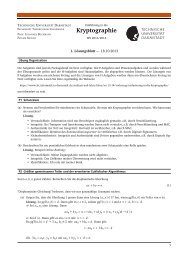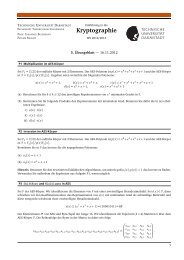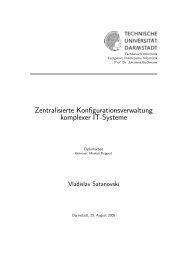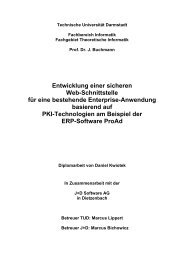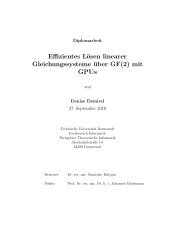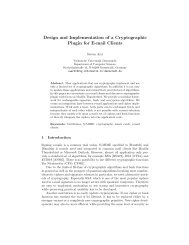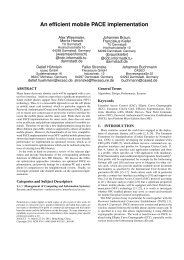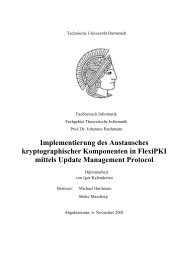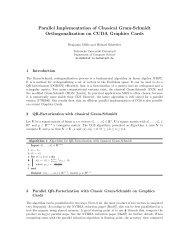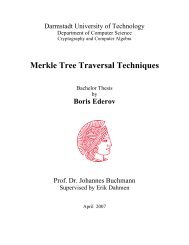Lattice Basis Reduction in Infinity Norm - Technische Universität ...
Lattice Basis Reduction in Infinity Norm - Technische Universität ...
Lattice Basis Reduction in Infinity Norm - Technische Universität ...
Create successful ePaper yourself
Turn your PDF publications into a flip-book with our unique Google optimized e-Paper software.
4 LLL<br />
The subject of lattice basis reduction theory was revived <strong>in</strong> 1981 with<br />
H.W.Lenstra’s work on <strong>in</strong>teger programm<strong>in</strong>g, which is based on a novel<br />
lattice reduction technique and works <strong>in</strong> polynomial time only for fixed dimensions.<br />
Lovász later developed a version of the algorithm which computes<br />
a reduced basis of a lattice <strong>in</strong> polynomial time for any dimension. The LLL<br />
algorithm, named after its creators, reached its f<strong>in</strong>al version <strong>in</strong> the paper of<br />
A.K. Lenstra, H.W. Lenstra and L. Lovász [7], where it is applied to factor<br />
rational polynomials with respect to the Euclidean norm. It computes<br />
a reduced basis after polynomial many steps. Further enhancements were<br />
<strong>in</strong>troduced later by Schnorr.<br />
In 1992 Lovász and Scarf [8] proposed a generalized lattice reduction algorithm,<br />
which was later named after them - LS algorithm. They extend the<br />
mean<strong>in</strong>g of an LLL-reduced basis to any norm. It works <strong>in</strong> polynomial many<br />
arithmetical operations and calculations of distance functions.<br />
We beg<strong>in</strong> this chapter with a short description of the mathematical mean<strong>in</strong>g<br />
of LLL-reduced bases. The orig<strong>in</strong>al LLL algorithm is then presented.<br />
This type of reduction is cont<strong>in</strong>ued with the LS algorithm that works with<br />
an arbitrary norm. F<strong>in</strong>ally, a specific enumeration for the <strong>in</strong>f<strong>in</strong>ity norm is<br />
<strong>in</strong>troduced.<br />
4.1 LLL-reduced <strong>Basis</strong><br />
Here we expla<strong>in</strong> the mean<strong>in</strong>g of an LLL-reduced basis and show the qualities<br />
of such a basis. Let ( ˆ b1, ˆ b2, ..., ˆ bm) be the ordered orthogonal system for<br />
the basis (b1, b2, ..., bm) ∈ R n and µi,j the Gram-Schmidt coefficient.<br />
Def<strong>in</strong>ition 4.1. An ordered lattice basis (b1, b2, ...., bm) ∈ Rn is called<br />
< δ ≤ 1, when:<br />
LLL-reduced for a parameter δ, such that 1<br />
4<br />
1. |µi,j| ≤ 1<br />
2<br />
for 1 ≤ j < i ≤ m<br />
2. δ · � ˆ bk−1 �2 2 ≤ � ˆ bk �2 2 + µ2 k,k−1 · � ˆ bk−1 �2 2 , for k = 2, 3, ...., m<br />
The quality of the reduced basis depends on the parameter δ : the bigger<br />
the value, the stronger the reduction of the basis. In the orig<strong>in</strong>al paper of<br />
Lenstra, Lenstra and Lovász the LLL algorithm is def<strong>in</strong>ed only for δ = 3<br />
4 .<br />
With the help of the orthogonal projection<br />
πk : R n → span(b1, b2, ...., bk−1) ⊥ .<br />
The second part of the def<strong>in</strong>ition could be written <strong>in</strong> the follow<strong>in</strong>g way:<br />
δ · � πk−1(bk−1) �2 2 ≤ � πk−1(bk) �2 2 , for k = 2, 3, ...., m.<br />
14





